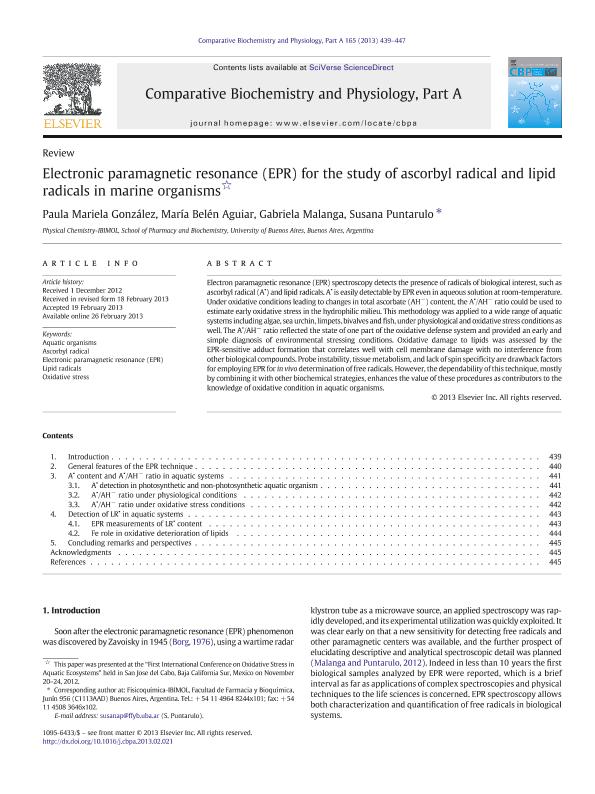Artículo
Electronic paramagnetic resonance (EPR) for the study of ascorbyl radical and lipid radicals in marine organisms
González, Paula Mariela ; Aguiar, María Belén
; Aguiar, María Belén ; Malanga, Gabriela Fabiana
; Malanga, Gabriela Fabiana ; Puntarulo, Susana Ángela
; Puntarulo, Susana Ángela
 ; Aguiar, María Belén
; Aguiar, María Belén ; Malanga, Gabriela Fabiana
; Malanga, Gabriela Fabiana ; Puntarulo, Susana Ángela
; Puntarulo, Susana Ángela
Fecha de publicación:
08/2013
Editorial:
Elsevier
Revista:
Comparative Biochemistry and Physiology Part A: Molecular and Integrative Physiology
ISSN:
1095-6433
Idioma:
Inglés
Tipo de recurso:
Artículo publicado
Clasificación temática:
Resumen
Electron paramagnetic resonance (EPR) spectroscopy detects the presence of radicals of biological interest, such as ascorbyl radical (A•) and lipid radicals. A• is easily detectable by EPR even in aqueous solution at room-temperature. Under oxidative conditions leading to changes in total ascorbate (AH−) content, the A•/AH− ratio could be used to estimate early oxidative stress in the hydrophilic milieu. This methodology was applied to a wide range of aquatic systems including algae, sea urchin, limpets, bivalves and fish, under physiological and oxidative stress conditions as well. The A•/AH− ratio reflected the state of one part of the oxidative defense system and provided an early and simple diagnosis of environmental stressing conditions. Oxidative damage to lipids was assessed by the EPR-sensitive adduct formation that correlates well with cell membrane damage with no interference from other biological compounds. Probe instability, tissue metabolism, and lack of spin specificity are drawback factors for employing EPR for in vivo determination of free radicals. However, the dependability of this technique, mostly by combining it with other biochemical strategies, enhances the value of these procedures as contributors to the knowledge of oxidative condition in aquatic organisms.
Archivos asociados
Licencia
Identificadores
Colecciones
Articulos(IBIMOL)
Articulos de INSTITUTO DE BIOQUIMICA Y MEDICINA MOLECULAR
Articulos de INSTITUTO DE BIOQUIMICA Y MEDICINA MOLECULAR
Citación
González, Paula Mariela; Aguiar, María Belén; Malanga, Gabriela Fabiana; Puntarulo, Susana Ángela; Electronic paramagnetic resonance (EPR) for the study of ascorbyl radical and lipid radicals in marine organisms; Elsevier; Comparative Biochemistry and Physiology Part A: Molecular and Integrative Physiology; 165; 4; 8-2013; 439-447
Compartir
Altmétricas



